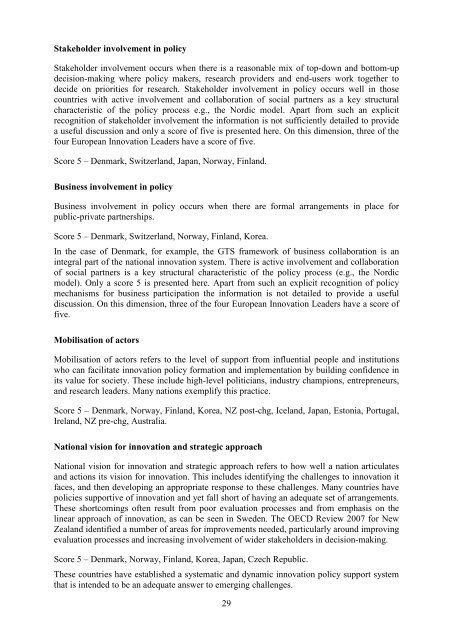Comparison of innovation policies in selected European, Asian and ...
Comparison of innovation policies in selected European, Asian and ...
Comparison of innovation policies in selected European, Asian and ...
You also want an ePaper? Increase the reach of your titles
YUMPU automatically turns print PDFs into web optimized ePapers that Google loves.
Stakeholder <strong>in</strong>volvement <strong>in</strong> policy<br />
Stakeholder <strong>in</strong>volvement occurs when there is a reasonable mix <strong>of</strong> top-down <strong>and</strong> bottom-up<br />
decision-mak<strong>in</strong>g where policy makers, research providers <strong>and</strong> end-users work together to<br />
decide on priorities for research. Stakeholder <strong>in</strong>volvement <strong>in</strong> policy occurs well <strong>in</strong> those<br />
countries with active <strong>in</strong>volvement <strong>and</strong> collaboration <strong>of</strong> social partners as a key structural<br />
characteristic <strong>of</strong> the policy process e.g., the Nordic model. Apart from such an explicit<br />
recognition <strong>of</strong> stakeholder <strong>in</strong>volvement the <strong>in</strong>formation is not sufficiently detailed to provide<br />
a useful discussion <strong>and</strong> only a score <strong>of</strong> five is presented here. On this dimension, three <strong>of</strong> the<br />
four <strong>European</strong> Innovation Leaders have a score <strong>of</strong> five.<br />
Score 5 – Denmark, Switzerl<strong>and</strong>, Japan, Norway, F<strong>in</strong>l<strong>and</strong>.<br />
Bus<strong>in</strong>ess <strong>in</strong>volvement <strong>in</strong> policy<br />
Bus<strong>in</strong>ess <strong>in</strong>volvement <strong>in</strong> policy occurs when there are formal arrangements <strong>in</strong> place for<br />
public-private partnerships.<br />
Score 5 – Denmark, Switzerl<strong>and</strong>, Norway, F<strong>in</strong>l<strong>and</strong>, Korea.<br />
In the case <strong>of</strong> Denmark, for example, the GTS framework <strong>of</strong> bus<strong>in</strong>ess collaboration is an<br />
<strong>in</strong>tegral part <strong>of</strong> the national <strong><strong>in</strong>novation</strong> system. There is active <strong>in</strong>volvement <strong>and</strong> collaboration<br />
<strong>of</strong> social partners is a key structural characteristic <strong>of</strong> the policy process (e.g., the Nordic<br />
model). Only a score 5 is presented here. Apart from such an explicit recognition <strong>of</strong> policy<br />
mechanisms for bus<strong>in</strong>ess participation the <strong>in</strong>formation is not detailed to provide a useful<br />
discussion. On this dimension, three <strong>of</strong> the four <strong>European</strong> Innovation Leaders have a score <strong>of</strong><br />
five.<br />
Mobilisation <strong>of</strong> actors<br />
Mobilisation <strong>of</strong> actors refers to the level <strong>of</strong> support from <strong>in</strong>fluential people <strong>and</strong> <strong>in</strong>stitutions<br />
who can facilitate <strong><strong>in</strong>novation</strong> policy formation <strong>and</strong> implementation by build<strong>in</strong>g confidence <strong>in</strong><br />
its value for society. These <strong>in</strong>clude high-level politicians, <strong>in</strong>dustry champions, entrepreneurs,<br />
<strong>and</strong> research leaders. Many nations exemplify this practice.<br />
Score 5 – Denmark, Norway, F<strong>in</strong>l<strong>and</strong>, Korea, NZ post-chg, Icel<strong>and</strong>, Japan, Estonia, Portugal,<br />
Irel<strong>and</strong>, NZ pre-chg, Australia.<br />
National vision for <strong><strong>in</strong>novation</strong> <strong>and</strong> strategic approach<br />
National vision for <strong><strong>in</strong>novation</strong> <strong>and</strong> strategic approach refers to how well a nation articulates<br />
<strong>and</strong> actions its vision for <strong><strong>in</strong>novation</strong>. This <strong>in</strong>cludes identify<strong>in</strong>g the challenges to <strong><strong>in</strong>novation</strong> it<br />
faces, <strong>and</strong> then develop<strong>in</strong>g an appropriate response to these challenges. Many countries have<br />
<strong>policies</strong> supportive <strong>of</strong> <strong><strong>in</strong>novation</strong> <strong>and</strong> yet fall short <strong>of</strong> hav<strong>in</strong>g an adequate set <strong>of</strong> arrangements.<br />
These shortcom<strong>in</strong>gs <strong>of</strong>ten result from poor evaluation processes <strong>and</strong> from emphasis on the<br />
l<strong>in</strong>ear approach <strong>of</strong> <strong><strong>in</strong>novation</strong>, as can be seen <strong>in</strong> Sweden. The OECD Review 2007 for New<br />
Zeal<strong>and</strong> identified a number <strong>of</strong> areas for improvements needed, particularly around improv<strong>in</strong>g<br />
evaluation processes <strong>and</strong> <strong>in</strong>creas<strong>in</strong>g <strong>in</strong>volvement <strong>of</strong> wider stakeholders <strong>in</strong> decision-mak<strong>in</strong>g.<br />
Score 5 – Denmark, Norway, F<strong>in</strong>l<strong>and</strong>, Korea, Japan, Czech Republic.<br />
These countries have established a systematic <strong>and</strong> dynamic <strong><strong>in</strong>novation</strong> policy support system<br />
that is <strong>in</strong>tended to be an adequate answer to emerg<strong>in</strong>g challenges.<br />
29

















